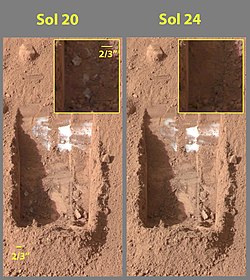Wikipedia:Featured picture candidates/Ice water evaporating on the surface of Mars
Appearance

- Reason
- high quality, historical picture
- Articles this image appears in
- Phoenix (spacecraft)
- Creator
user:DragonFire1024NASA/JPL
- Support as nominator --Nergaal (talk) 03:11, 20 November 2008 (UTC)
- Comment - a very important image, but could we get a version with less JPG compression? —Vanderdecken∴ ∫ξφ 10:37, 20 November 2008 (UTC)
- Support I think we can forgive some JPG compression due to the high encyclopedic value of the image. How likely is it NASA will give us a better pic? Fletcher (talk) 15:15, 20 November 2008 (UTC)
- Strong oppose Horrid JPEG artifacts, ugly yellow text on gray background. I'm sure it wouldn't be too difficult to find the originals and arrange them properly. This really isn't FP material. Space images should be of highest quality, it's not like they're beamed to earth as tiny 75% quality JPEGs. TheOtherSiguy (talk) 02:46, 21 November 2008 (UTC)
- Strong oppose Not fp quality, and if zoomed close, shadow detail has coloration. —Preceding unsigned comment added by ZooFari (talk • contribs) 05:39, 21 November 2008 (UTC)
- Comment. The objections above are valid, but I wonder what quality camera these landers are using. This may well be as good as it gets, and EV does seem high, and certainly not easily repeatable photos. I wonder if someone into this stuff can clarify (sorry, I'm too lazy to try to look it up myself atm). --jjron (talk) 08:19, 21 November 2008 (UTC)
- Comment: Why, why such a cumbersome size reference as 2/3"? either 1", or 10mm or 20 mm, but not 2/3"! --Janke | Talk 09:00, 21 November 2008 (UTC)
- Comment: Here are the raw files. I haven't a clue how to Photoshop them into a color image. http://www.met.tamu.edu/mars/020.html and http://www.met.tamu.edu/mars/024.html Chicago god (talk) 22:19, 21 November 2008 (UTC)
- Open the red, green and blue images as layers (in the Gimp, it's File -> Open as layer) so that the blue is on the bottom and red on top. Set each layer to 33% opacity and add a white background layer. Colorize each image layer (Filters -> Colors -> Colorify) with their respective colors. Then flatten the image and boost both the brightness and contrast. I'm not sure of the true color accuracy of this, but hey it works. MER-C 01:53, 22 November 2008 (UTC)
- Those images are no larger and are also jpegs so it's probably not going to help much. I would be very surprised if they were beamed to earth with any kind of lossy compression - it would make any kind of reasearch on the images difficult. They are far more likely sending RAW sensor data of some kind with lossless compression. It's odd that they don't make anything larger or any TIFF versions available though. Mfield (talk) 01:58, 22 November 2008 (UTC)
- Actually had an engineer that worked on the design of the phoenix lander come and give a lecture at uni, one thing I took away from that was how limited the supply of energy was on the lander, and that the radiation hardened computers they use are relatively slow by today's consumer PC standards. I'd imagine that compression is probably relatively costly in terms of energy and computation time so a non artifacted version might be availible. I wouldn't be expecting a higher resolution shot though unfortunately. Noodle snacks (talk) 08:34, 22 November 2008 (UTC)
- Comment: I believe that evaporation and sublimation are different. If the ice is sublimating then the air pressure on Mars is such that liquid water cannot exist. Is that true? --BellCurve (talk) 21:53, 22 November 2008 (UTC)
- Probably a fair point. Are you suggesting the nomination is mistitled? --jjron (talk) 07:33, 25 November 2008 (UTC)
- They are different, but sublimation takes place on Earth too. Rich Farmbrough, 15:42, 23 March 2012 (UTC).
Not promoted MER-C 02:33, 27 November 2008 (UTC)
